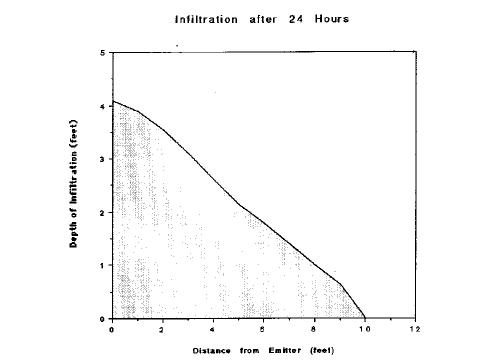In order to properly irrigate any crop, you need to know how much water you are putting onto the crop. A grower with a small acreage recently asked how to irrigate avocados, and I said amongst other things that it is not only necessary to know how much water the emitters are spraying, but where that water is going. Each manufacturer rates output at a certain flow at a certain pressure. So at 20 psi a rated emitter will put out something like 8, 9, 10, 14 gpm, whatever. If pressure changes, the output changes and some emitters respond to pressure change more than others.
As elevation and distance from the inflow valve changes, pressure changes. That can be corrected by using pressure compensation in-line or at the emitter or both. So even if pressure changes, there will be a known output if the manufacturer has done right by the product. Then it is up to the grower to make sure that clogging, filter cleaning and other maintenance practices are followed.
So now the grower is left with where the water is going. When an orchard is about 8 years old in a conventional planting, the roots of all the trees are starting to get entangled amongst themselves. It becomes one big root system. So you may not think that it matters what pattern the water takes. It all gets to the trees, right? No. Because most microsprinklers as far as I know put out a pattern that puts less water in the pattern than in other parts of the pattern. Typically the water decreases with distance from the microspinkler. Lots of water near the emitter that also leaches accumulated salts from the profile, but with distance, the amount decreases and leaching decreases. The wetted pattern might look like a nice circle, but salt will accumulate with depth in that pattern because there is not sufficient water arriving at that point to drive the water below the root zone. Rain makes up for this faulty wetted pattern by leaching those accumulated salts from those underirrigated areas. A grower could compensate for lack of rain by running the system for a much longer time to make sure those poorly leached areas get a good wetting. But in a drought and with high water costs growers hesitate to put on more than they think might be necessary.
Once salt damage has occurred, though, it is not going to go away. Eventually the tree will shed those leaves and the tree will become less productive. Therefore it is important to know how much of that water is not adequately leaching the salts that are naturally occurring in the irrigation water. So our grower followed a little trial that is very commonly done in the turf trade. He put out catch cans (tuna cans with lids removed) and looked at the spray pattern of the microspinklers. He ran the system for increasing amounts of time and was able to get an idea of how much water could infiltrate at one spot.
He could then place the emitters in a pattern that might more effectively leach salts. First of all he knew that he didn't want the spray pattern to hit the tree trunks to avoid crown rot. So he could then move the emitters further away from the trunks. Also the most efficient roots for water uptake are not right at the trunk. That's where coarser roots are and much of the water will bypass them. Where the fine roots are, are further out from the trunk. So he could then move them out a little further from the trunk. At this point there comes some overlapping of the emitter spray patterns so there will be increased leaching occurring where the overlap occurs.
You can probably see where this is going. The optimum distance for a relatively mature orchard is when the emitters are midway in between trunks and there is some overlap of spray patterns. It might be necessary to on higher output emitters to make sure there is some overlap within reason. This would make the pattern of output more or less even across the wetted area. It will never be perfectly even, though, because that is not how microspinklers were designed. The grower now has a better handle on where that water was going.
1) Spray pattern with distance from the emitter (top graph).
2) Salt accumulation with depth and distance in that spray pattern (bottom graph).
Attached Images:

